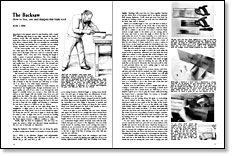
Synopsis: “Backsaw” is a generic name for any handsaw with a metal stiffening strip along its top edge, opposite the teeth. Ian J. Kirby says it’s a versatile tool for cutting tenons, dovetails and other joints, and for clean crosscuts. He divides backsaws into two groups — tenon saws and dovetail saws– and describes sizes and styles available. If you buy one by mail, he says, be sure to check it carefully for misalignment and straightness. He explains how to grip it and position or clamp the work to be sawn, both with the grain and crosscutting. He offers specific tips on cutting tenons and dovetails and problems that often plague beginners. Side information explains how to sharpen a backsaw.
Backsaw is the generic name for any handsaw with a metal stiffening strip along its top edge, opposite the teeth. A backsaw works like any handsaw that cuts on the push stroke, but a finer cut is possible because the saw’s reinforcing strip allows a thinner blade. This saw shouldn’t be overlooked by the machine woodworker—it’s a versatile tool for cutting tenons, dovetails and other joints, and for clean crosscuts.
Of the better-quality saws now manufactured, there are two main types—the tenon saw and the dovetail saw. The tenon saw is the larger of the two, and it is commonly sold in three lengths: 10-in., 12-in, and 14-in. Selecting the length is really a matter of personal preference. The 12-in. length is probably the most useful; the 14-in. is heavier and therefore more difficult to use. Tenon-saw blades are about 4 in. wide and usually have 13 or 15 points per inch. The dovetail saw looks like a miniature version of the tenon saw. It is commonly 8 in. long and about 3½in. wide, with 20 points to the inch. Dovetail saws with blades 2 in. wide are sold. These usually have a turned rather than a pistol-grip handle.
The dovetail saw’s finer teeth leave a smoother surface than does a tenon saw, inviting its use for cutting tenons. Don’t yield to the temptation, because dovetail saws are quite delicate and should be reserved for sawing thin wood. A good rule of thumb is that the dovetail saw will keep an accurate cut 1 in. deep in 1-in. thick maple, maximum.
The best-quality backsaws available in North America are brass-backed and English-made, though steel-backed saws of good quality are sold. If you order a saw through the mail, inspect it carefully before you accept it. First, hold the saw end-on at arm’s length with the handle away from you and sight down the blade. The sides of the brass back should be parallel to the sides of the blade. Misalignment doesn’t affect the way the saw cuts, but sighting along the back is the easiest way to keep the saw upright, and learning to compensate for one that is askew is a skill you can do without.
Next, turn the saw teeth up and sight along them for straightness. A slight curve at one end or the other can be gently bent out of the blade, but an S-curve should be rejected. Rotate the saw 90° and view it again to check the blade for wind or twist. A slight twist can be corrected by bending it the other way. An inaccurately mounted handle may make the blade appear twisted, a difficult condition to adjust.
Finally, sight the back for straightness. This isn’t easy, because the metal is folded and distorted during manufacture, but you can at least gain an impression.
From Fine Woodworking #39
For the full article, download the PDF below:
Fine Woodworking Recommended Products

Wen Diamond Grinding Wheel

Stanley Powerlock 16-ft. tape measure

Veritas Wheel Marking Gauge




















Log in or create an account to post a comment.
Sign up Log in